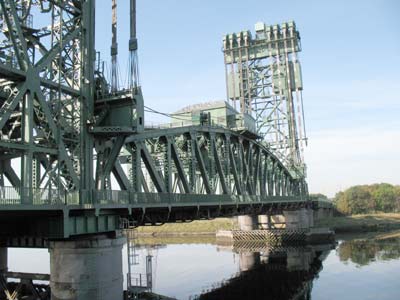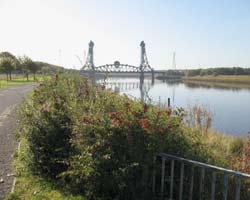
NEWPORT VERTICAL LIFT BRIDGE

"Although no longer operational due to the river's changed usage, the lifting mechanism stands as a monument to nineteenth-century ingenuity and enterprise."
The Teesdale Way. Martin Collins. 2005
The Tees Vertical Lift Bridge is a massive steel structure which opened in February 1934, and was the first to be built in the UK and the heaviest of its kind in the world. The requirement for a bridge to replace the existing ferry was complicated, as in the case of the Transporter Bridge, by the fact that the riverbanks are low and a conventional bridge would require lengthy approach roads to give the height necessary for ships to pass under. It was designed by Mott, Hay and Anderson and built by Dorman Long, a local firm at a cost of £437000. The foundation stones were laid on 14 July 1932 and the bridge opened only 19 months later by the Duke of York. The bridge has a vertical lift of 37 metres, its vertical towers ar 55 metres and is 82 metres long (combined length of bridge and approaches is 4920 feet) and its lifting span is counterbalanced by weights. Operated by two 325 horsepower electric motors and a stand-by petrol engine, but with provision for manual lifting in the event of electrical failure. Lifting the centre span took 90 seconds to complete. Ships passing up river to Stockton would require the bridge to be lifted, up to 1400 times per week at its peak, but as the number of vessels declined as Stockton's port activities decreased, and with the construction of the Tees Barrage it was no longer needed and was bolted down after its final lift in 1990.
It provides a road link, single carriageway only, on the A1032 between Middlesbrough and Stockton/Billingham and its massive form, repainted in its original green, can be seen for miles.
- Constructed - 1932-1934
- Type - lift bridge.
- Position: Middlesbrough.
- Grid Ref: NZ 478 198

